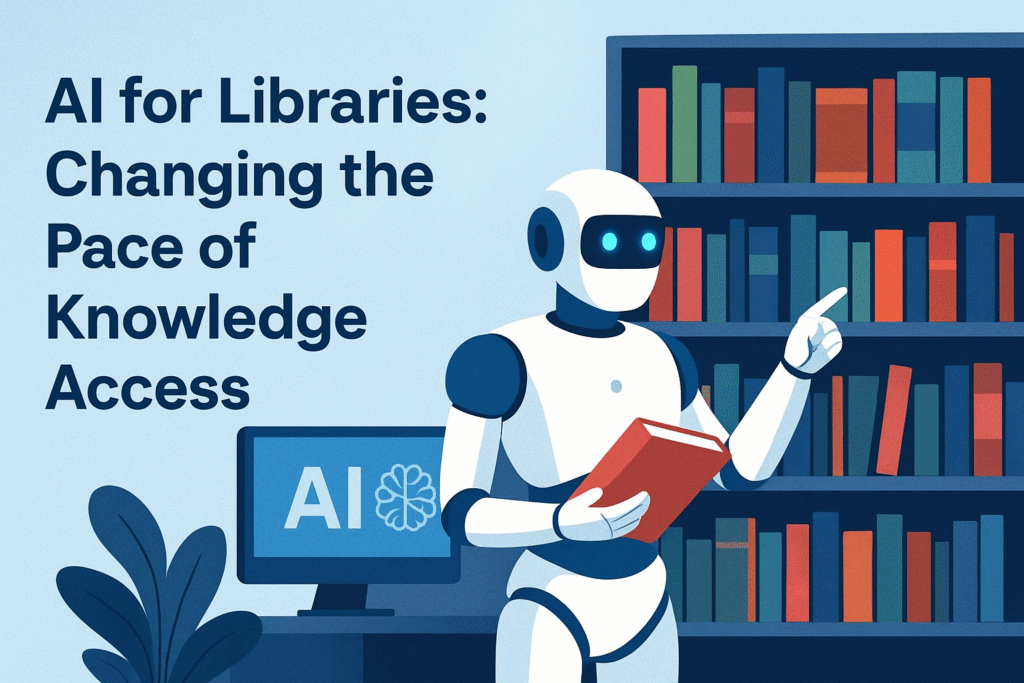Have you ever dreamed of having a library that could think, learn, and assist you like a human librarian does? Artificial Intelligence (AI) is making that dream a reality. AI is changing the way libraries are run — from handling catalogs and automating chores to improving user experiences and increasing research efficiency.
In this post, we’ll explore how AI is revolutionizing libraries, the advantages it offers, and what might be in store for librarians and readers alike.
AI: What It Is and Why Libraries Should Care
Artificial Intelligence (AI) refers to machines and software that imitate human intelligence — learning, reasoning, and self-correction.
In libraries, AI is being deployed to efficiently manage massive amounts of data, optimize services, and personalize user experiences.
Libraries have always been about connecting people with knowledge. But as the volume of information explodes, traditional systems can’t always keep up. That’s where AI steps in — to simplify complexity and offer smarter, faster, more intuitive services.
Automating Cataloging and Classification
Cataloging is one of the most time-consuming tasks in libraries.
Thanks to machine learning and natural language processing (NLP), AI can now automatically classify books and digital content by subject, keywords, and context.
For instance, systems such as OCLC’s WorldCat and Koha with AI extensions can analyze text, determine topics, and assign metadata within minutes. This saves time, reduces errors, and improves consistency across collections.
✨ Benefits: Saves time, boosts accuracy, and lets librarians focus on meaningful work.
Personalized Recommendations for Readers
Just like Netflix recommends movies, AI can suggest what to read next.
Libraries can use AI-powered recommendation engines to analyze users’ borrowing histories and suggest similar or related titles.
Example: If a user reads books about machine learning, the system could recommend materials on data analytics or AI ethics.
🎯 Result: Increased engagement, greater satisfaction, and smarter discovery.
Smarter Search and Information Retrieval
Traditional keyword searches often produce too many irrelevant results.
AI changes that with semantic search and NLP, understanding the intent behind user queries.
Now, instead of typing “Shakespeare plays love theme,” users can ask:
“Which Shakespeare plays explore the theme of love?”
AI search tools interpret the question naturally and return accurate, relevant results.
Libraries such as the British Library and major universities are already using AI-based search systems to speed up research.
Chatbots and Virtual Library Assistants
Imagine having a librarian available 24/7 — that’s exactly what AI chatbots offer.
These virtual assistants can answer FAQs, help find books, renew loans, and guide users through online resources.
Chatbots like Ask a Librarian now use conversational AI to provide multilingual support and quick responses.
📚 Benefit: Instant help, improved accessibility, and reduced staff workload.
Predictive Analytics for Resource Management
AI also works behind the scenes through predictive analytics.
Libraries can analyze borrowing patterns to forecast demand, optimize budgets, and improve acquisitions.
Example: A university library can predict a spike in demand for “AI textbooks” before the new semester and order extra copies in advance.
🔍 Result: Better planning, smarter spending, and more satisfied users.
AI and Digital Preservation
Libraries safeguard rare manuscripts, images, and recordings — AI helps preserve them.
Machine learning and Optical Character Recognition (OCR) technologies detect file corruption, restore faded texts, and convert analog archives into searchable digital form.
Outcome: Priceless historical materials are protected and made accessible to future generations.
AI-Powered Research Support
AI tools like Semantic Scholar, Research Rabbit, and Iris.ai can scan thousands of academic papers, summarize findings, and suggest related work.
Libraries that adopt these tools enable students and researchers to explore topics faster and deeper — automating citation management, plagiarism checking, and literature mapping.
⚡ Benefit: Smarter, faster, more connected research.
Improving Accessibility and Inclusivity
AI promotes inclusivity by making libraries accessible to everyone, including people with disabilities.
Examples:
- Voice-based navigation for the visually impaired
- Text-to-Speech (TTS) conversion for those with reading challenges
- Real-time translation tools to break language barriers
🌍 Result: Libraries become open, inclusive spaces for all.
Managing Information Overload
We live in an age of information overload — millions of papers and posts daily.
AI helps librarians filter out low-quality or irrelevant content and highlight credible, high-value sources.
By identifying misinformation and ranking trustworthy materials, AI supports academic integrity and reliable knowledge discovery.
AI in Library Security and Space Management
AI also makes physical libraries smarter.
Using smart cameras and sensors, libraries can monitor space usage, track visitor flow, and even adjust lighting or temperature based on occupancy — reducing costs and supporting sustainability.
🛡️ Bonus: Enhanced security and eco-friendly operations.
Challenges and Ethical Concerns
Of course, AI in libraries comes with challenges:
- Privacy: Data collection raises user-privacy issues.
- Bias: AI systems reflect the biases of their training data.
- Cost: Smaller libraries may struggle with expensive implementations.
- Job Fears: Some worry AI could replace librarians.
But remember — AI isn’t replacing librarians; it’s empowering them.
It automates repetitive tasks so humans can focus on what matters most — community engagement, research support, and education.
The Future of AI in Libraries
The future is bright.
Libraries are evolving into smart learning ecosystems that blend AI, augmented reality (AR), and data analytics.
Expect virtual research assistants, immersive VR learning spaces, and fully integrated discovery platforms that connect users to every type of resource seamlessly.
Conclusion
AI is transforming libraries from traditional knowledge stores into smart, dynamic knowledge hubs.
From automating cataloging to providing personalized services, AI bridges the gap between human expertise and digital efficiency.
Rather than replacing librarians, AI frees them — enabling a future where human wisdom and artificial intelligence work together to make knowledge truly accessible to all.
